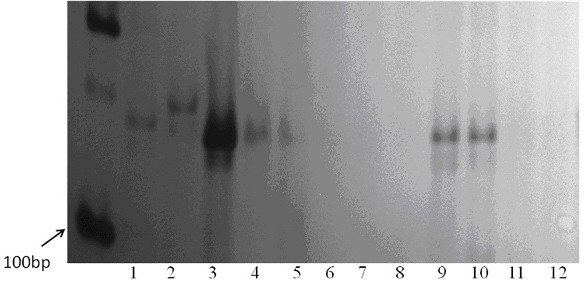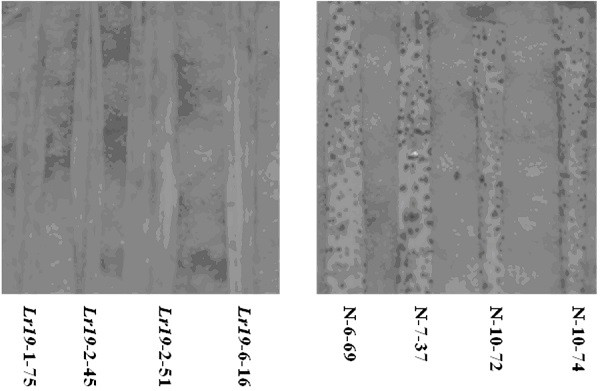A molecular marker and its application for rapid detection of leaf rust resistance gene in Thiopyrum elongatum
A technology of leaf rust resistance gene and Echinopsis elongatum, which is applied in the field of molecular genetic breeding, can solve the problems of common wheat chromosome exchange, difficulty in the application of genetic breeding, difficult fine positioning and closely linked marker development, etc., to achieve convenient cloning and improve Breeding efficiency, using accurate results
- Summary
- Abstract
- Description
- Claims
- Application Information
AI Technical Summary
Problems solved by technology
Method used
Image
Examples
Embodiment 1
[0033] Example 1 Creation of short-segment materials resistant to leaf rust of wheat-Thinopyrum elongatum
[0034] In 2015, the hybrid combination (KS11695×CS Ph1b mutant) was configured in the greenhouse of Shandong Agricultural University and obtained F 1 ; In 2016, will receive F 1 with CS- Ph1b Mutants are hybridized to obtain BC 1 f 1 , and carry out molecular marker identification on the obtained plants, on the basis of molecular marker identification, the BC carrying target gene and exogenous fragment 1 f 1 BC 1 f 2 . In 2016 and 2017, with the help of molecular markers, short-segment translocation lines of wheat-Thinopyrum elongatum were obtained, and their resistance to leaf rust was identified.
Embodiment 2
[0035] Example 2 Anti-rust gene of Thiopyrum elongatum Lr19 Development of Tightly Linked Molecular Markers
[0036] According to the published sequence information of the D genome of A. taustus, and downloading the scaffold near the end of the 7DL chromosome, the Chinese spring mutant, K11695, 7el 1 (7D) and Thinopyrum ponticum were used as materials for PCR amplification to search for molecular markers closely linked to the leaf rust resistance gene Lr19.
[0037] In the PCR amplification reaction system, the PCR reagent composition is: 2 μl template containing 50-100ng DNA (from Chinese spring mutant, K11695, 7el 1 (7D) and Genomic DNA extracted from Th. ponticum), 1.5μl 10× PCR buffer (containing Mg 2 + ), 1.2 μl ldNTP, left and right primers (SEQ ID No.1 and SEQ ID No.2), 0.15 μl R-Taq DNA polymerase, 8.15 μl H 2 O. The PCR amplification program was pre-denaturation at 94°C for 5 min; then denaturation at 94°C for 50 s, annealing at 49°C for 40 s, and extension at 72...
Embodiment 3
[0038] Example 3 Leaf Rust Resistance Gene of Echinopsis elongatum Lr19 Validation of tightly linked molecular markers
[0039] to 7el 1 、7el 2 , Thinopyrum ponticum, k11695, CS- ph1b , JM22, LDN, 2147, and short-fragment screening offspring were used as experimental materials to verify the obtained molecular marker Xsdau798,
[0040] In the PCR amplification reaction system, the PCR reagent composition is: 2 μl template containing 50-100ng DNA (from 7el 1 、7el 2 , Thinopyrum ponticum, k11695, CS- ph1b , JM22, LDN, 2147, genomic DNA extracted from short fragment screening offspring), 1.5μl 10× PCR buffer (containing Mg 2+ ), 1.2 μl dNTP, left and right primers (SEQ ID No.1 and SEQ ID No.2, SEQ ID No.3 and SEQ ID No.4), 0.15 μl R-Taq DNA polymerase, 8.15 μl H 2 O. The PCR amplification program was pre-denaturation at 94°C for 5 min; then denaturation at 94°C for 50 s, annealing at 49°C for 40 s, and extension at 72°C for 60 s, 35 cycles; finally, extension at 72°C for...
PUM
 Login to View More
Login to View More Abstract
Description
Claims
Application Information
 Login to View More
Login to View More - R&D
- Intellectual Property
- Life Sciences
- Materials
- Tech Scout
- Unparalleled Data Quality
- Higher Quality Content
- 60% Fewer Hallucinations
Browse by: Latest US Patents, China's latest patents, Technical Efficacy Thesaurus, Application Domain, Technology Topic, Popular Technical Reports.
© 2025 PatSnap. All rights reserved.Legal|Privacy policy|Modern Slavery Act Transparency Statement|Sitemap|About US| Contact US: help@patsnap.com


